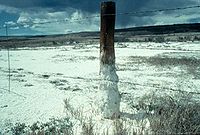
Photo from wikipedia
Resource utilization of urban green waste compost for soil improvement in afforested land is an important way of digesting urban green waste. In this study, artificial Sophora japonica Linn. Woodland… Click to show full abstract
Resource utilization of urban green waste compost for soil improvement in afforested land is an important way of digesting urban green waste. In this study, artificial Sophora japonica Linn. Woodland in the Beijing plain, where the million mu (66,700 ha) afforestation project was carried out, was taken as an experimental area to investigate the influences of urban green waste composting on soil improvement and soil microorganisms. Application amounts of green waste composts for each tree were as follows: CK treatment: no application of fertilizer; T1 treatment: 5 kg/each tree; T2 treatment: 10 kg/each tree; T3 treatment: 15 kg/each tree. Results showed that the application of green waste had a significant effect on soil improvement, such as improving of organic matter, available phosphorus, and available potassium content (p < 0.05). The high-level application amount (T3 treatment) had a greater effect on soil improvement. Compared with the control treatment (CK), soil pH in T3 treatment decreased to 7.28–7.45, Soil organic matter contents reached more than 35 g·kg−1, and soil total nitrogen, soil available phosphorus, and soil available potassium increased by 25–28%, 200–400%, and 80–177%, respectively. Soil carbon–nitrogen ratio has increasing to 15.61–24.38 in the three treatments, which would not obviously slow down the decomposition of organic matter by microorganisms in the soil. After the application of green waste compost, the soil microbial structure was changed. From the operational taxonomic unit (OTU) level, bacterial abundance increased by 12–13%, but the change in bacterial diversity was not significant. The influences of pH and contents of organic matter content, available phosphorus, and rapidly available potassium on the bacterial community were greater. This study will provide the necessary scientific basis for the application of green waste compost in the improvement of soil on afforested land in the Beijing plain.
Journal Title: Sustainability
Year Published: 2018
Link to full text (if available)
Share on Social Media: Sign Up to like & get
recommendations!